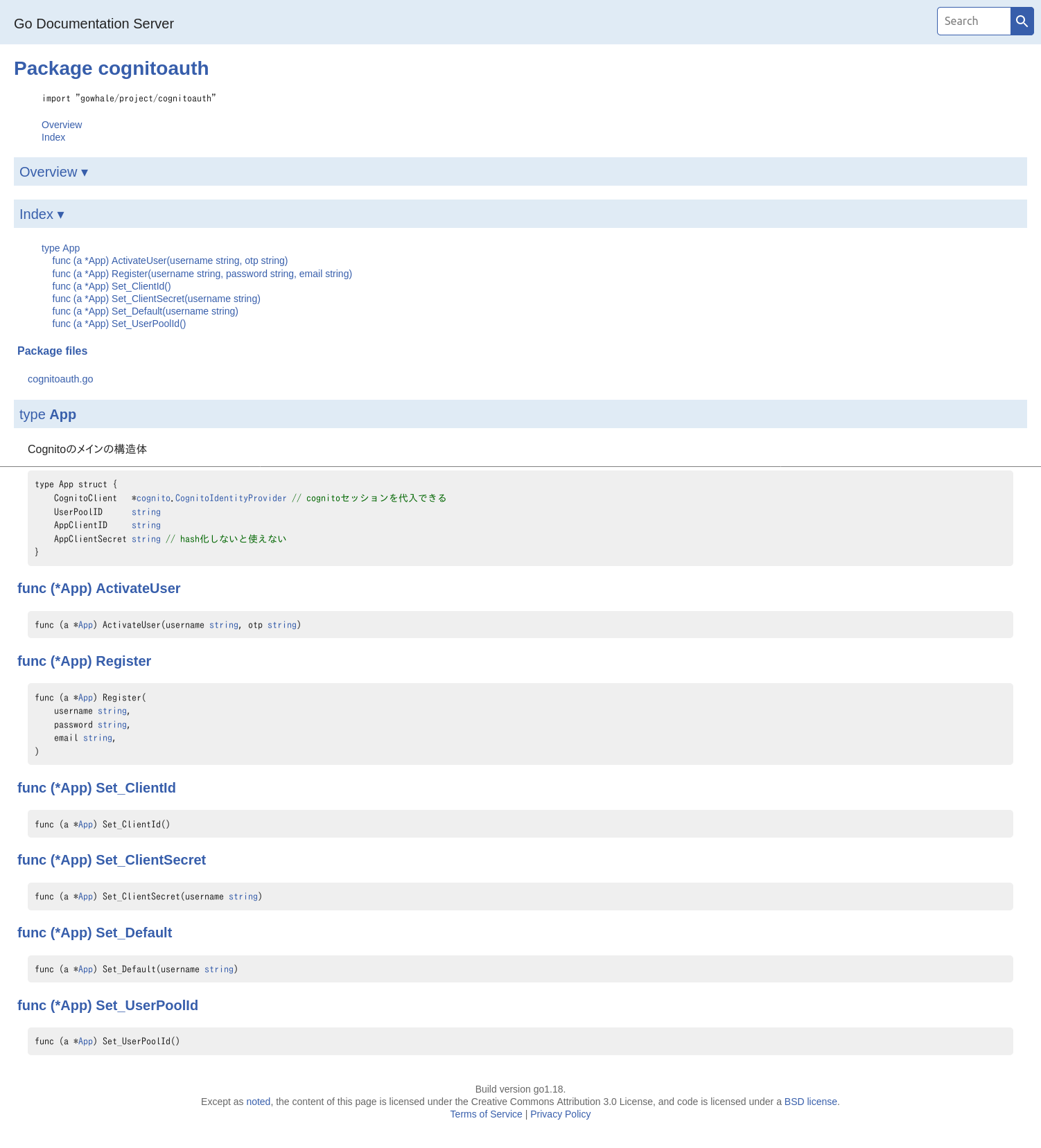注意
細かいエラー処理などはしていないのであくまでも参考程度にしてください。
ほとんどなぐり書きなので使う前にコードを整えてから使ってください。
共通の環境引数
- export CLIENTSECRET=
- export CLIENTID=
- export USERERPOOlID=
##ライブラリの全体像
ライブラリ
cognitoauth.go
package cognitoauth
import (
"crypto/hmac"
"crypto/sha256"
"encoding/base64"
"fmt"
"os"
"github.com/aws/aws-sdk-go/aws"
cognito "github.com/aws/aws-sdk-go/service/cognitoidentityprovider"
)
type App struct {
CognitoClient *cognito.CognitoIdentityProvider
UserPoolID string
AppClientID string
AppClientSecret string
}
func computeSecretHash(clientSecret string, username string, clientId string) string {
mac := hmac.New(sha256.New, []byte(clientSecret))
mac.Write([]byte(username + clientId))
return base64.StdEncoding.EncodeToString(mac.Sum(nil))
}
func (a *App) Set_ClientSecret(username string) {
a.AppClientSecret = computeSecretHash(
os.Getenv("CLIENTSECRET"),
username,
a.AppClientID,
)
}
func (a *App) Set_ClientId() {
a.AppClientID = os.Getenv("CLIENTID")
}
func (a *App) Set_UserPoolId() {
a.UserPoolID = os.Getenv("USERPOOLID")
}
func (a *App) Set_Default(username string) {
a.Set_ClientId()
a.Set_UserPoolId()
a.Set_ClientSecret(username)
}
func (a *App) Register(
username string,
password string,
email string,
) {
a.Set_ClientId()
a.Set_ClientSecret(username)
user := &cognito.SignUpInput{
Username: aws.String(username),
Password: aws.String(password),
ClientId: aws.String(a.AppClientID),
SecretHash: aws.String(a.AppClientSecret),
UserAttributes: []*cognito.AttributeType{
{
Name: aws.String("email"),
Value: aws.String(email),
},
},
}
_, err := a.CognitoClient.SignUp(user)
if err != nil {
fmt.Println(err)
return
}
}
func (a *App) ActivateUser(username string, otp string) {
// func (c *CognitoIdentityProvider) ConfirmSignUp(input *ConfirmSignUpInput) (*ConfirmSignUpOutput, error)
a.Set_ClientId()
a.Set_ClientSecret(username)
// usernameをpre-session-cookieでDynamoから取得する
user := &cognito.ConfirmSignUpInput{
ConfirmationCode: aws.String(otp),
Username: aws.String(username),
ClientId: aws.String(a.AppClientID),
SecretHash: aws.String(a.AppClientSecret),
}
fmt.Println("")
_, err := a.CognitoClient.ConfirmSignUp(user)
if err != nil {
fmt.Println(err)
return
}
}
会員登録
フロントからの入力
- username
- password(できれば2回入力させてチェック)
cognito_test.go
func TestRegistration(t *testing.T) {
var username = ""
var password = ""
var email = ""
// AWSの認証
conf := &aws.Config{Region: aws.String("ap-northeast-1")}
// AWSとの新規セッションを作成
sess, err := session.NewSession(conf)
// session作成をが失敗したときのエラー処理
if err != nil {
panic(err)
}
// cognitoのインスタンスを作成する
example := App{
CognitoClient: cognito.New(sess),
}
//user登録をする
example.Register(
username,
password,
email,
)
}
会員登録をしたユーザーの有効化
cognito_test.go
func TestActivateUser(t *testing.T) {
// AWSの認証
conf := &aws.Config{Region: aws.String("ap-northeast-1")}
// AWSとの新規セッションを作成
sess, err := session.NewSession(conf)
var username string = ""
var otp string = ""
// session作成をが失敗したときのエラー処理
if err != nil {
panic(err)
}
// cognitoのインスタンスを作成する
example := App{
CognitoClient: cognito.New(sess),
}
// 登録後の有効化
example.ActivateUser(username, otp)
}
